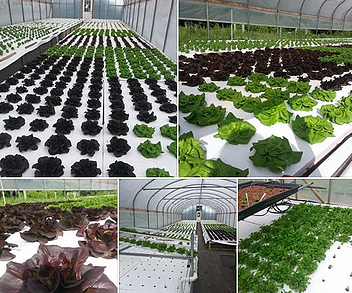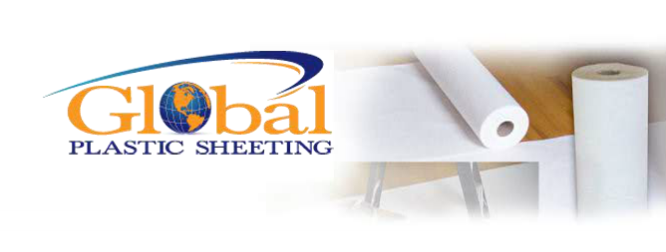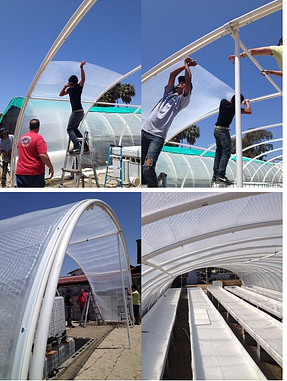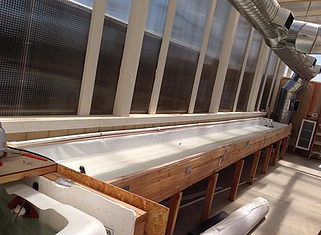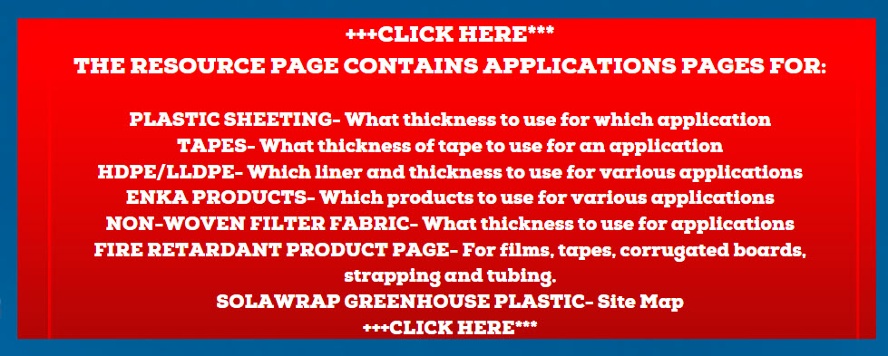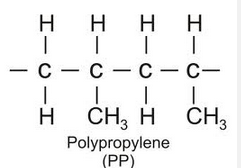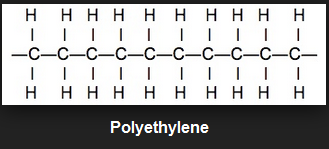What is Plastic Sheeting/ visqueen? Can it be recycled? What are some of the more common uses?
Click here for a quick video!
Plastic sheeting is also referred to as "plastic film, visqueen, poly". An analogy would to plastic wrap one uses to cover food, only much thicker and it much bigger rolls. Visqueen is a brand of polyethylene plastic sheeting that is usually LDPE. Polyethylene can be recycles and breaks down in the sun if it doesn't have a UV additive to protect it.
There are so many varied uses for plastic sheeting which is often referred to interchangeably as "Visqueen." It's important to note that most of the plastic sheeting on this site is engineered plastic not "visqueen". Engineered plastic is made from virgin resins, not reground plastic. Let's explore twelve of the common uses.
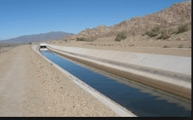
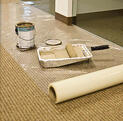
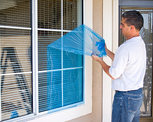
- Shelters or Temporary Protection
When hurricanes strike or disasters ensue, its plastic sheeting that is often used to create temporary shelters. Often string reinforced plastic is used because it is stronger and will hold up to wind.
- Coverings for Outdoor Equipment, Wood Piles, Furniture
String Reinforced plastic sheeting is commonly used as well as non-reinforced plastic to make covers for a variety of items. Grommets and hems can be added to the plastic so it can be held down in place.
- Waterproofing Ponds, Lakes, Canals
Liners for ponds, lakes and canals use a variety of plastic sheeting called, High Density Polyethylene or HDPE to line their basins. This virgin poly will hold up to the sun and elements.
- Recreational Uses such as Ice Skating Rinks, Slip and Slides
The beauty of plastic sheeting is it can be engineered for specific uses. With the addition of special additives, plastic sheeting can work long and hard for the application it was designed for. Ice skating rinks and slip and slides are an example of this. Very large or long rolls of plastic can be ordered from a manufacturer to serve these purposes.
There is special plastic sheeting that does not harm fish or humans and can thus be used for rain collection or aquaponics. Plastic can leach out chemical especially if it is construction and agricultural grade- as that plastic is mixed with regrind that is not pure virgin polyethylene.
- Closing Off Rooms for Remodeling
With the help of an amazing product called ZipWall which will hold plastic sheeting up to the ceiling- you can close off a room where work is being done. This is especially great if dust is flying around from workman activities.
- Abatement work for Lead Paint
Lead paint abatement is a big deal. It is very important that lead paint that is being scrapped off a surface does not contaminate other rooms in the house. This is a great place to use plastic sheeting. Anti-static fire retardant plastic is a great choice for this application because the lead dust won't stick to the plastic sheeting. It can be swept up and removed.
There are full lines of plastic that have adhesive on one side so they can stick to the surface they are protecting! Each type (Carpet Plastic, Tile Plastic, Countertop Plastic, etc) have specially formulated adhesive so it sticks just right to that surface. For example, you need a stronger adhesive to stick the plastic to carpeting than you do for plastic being applied to counter. Self-adhesive plastics are great for protecting surfaces from dogs, children's activities, adult parties and more!
- Black Out Curtain for Halloween, Movie Sets, Museum Work
Black fire retardant plastic sheeting is used all the time by commercial haunted houses, movie sets, aerospace companies and museums to list a few. This plastic is certified to be fire retardant- thus not contributing to a fire should one ensue.
Plastic polyethylene sheeting has been used for years and years to create greenhouses. Today there are state of the art coverings for greenhouses that last a lot longer than the old school 6 mil plastics of yester-year. This remarkable product is called, SolaWrap! It is plastic sheeting with bubbles in the layers. The bubbles act to insulate the house from heat and cold, while adding strength. There are a lot more attributes that you can learn about by clicking on the link.
Today there is a specialized type of plastic sheeting that has been created especially for aquaponics. It is called Ultra FGC. Ultra FGC is a food grade compliant liner that was engineered to be not only better for the environment, but better for your business. When we speak of the environment we mean minimizing the raw material usage- thus leaving a smaller environmental footprint. It's better for your business because we reduced the weight of the liner while increasing the capabilities and strength of the plastic.
Moisture resides in the earth and has a way of finding its way to the surface. This moisture is a problem for concrete slabs and the flooring that will be placed on the concrete. Under Slab vapor barriers are plastic sheeting barriers that are placed below the concrete to block the water from reaching the concrete. Vapor barriers do have low levels of moisture permeance. Get a copy of the spec sheet for the vapor barrier to understand what grade of vapor barrier is being placed under the slab.
Back in the 1950's a 6 m
il layer of plastic sheeting was used as a "vapor barrier". Unfortunately, 6 mil plastic still lets water pass through its cell allowing water to come through. 6 mil is so thin, that often it tears when it is put in place. A stronger less permeable is a much safer solution.
Plastic sheeting is a polyethylene film that comes in many different colors and thicknesses. It also comes in a variety of grades or qualities.
Grades of Plastic Sheeting
"Virgin Polyethylene" is the highest form of plastic sheeting today. This varies wildly from Visqueen. Visqueen has become one of the generic names for plastic sheeting, just as Kleenex has become the generic name for tissue. When someone asks for Visqueen, they are referring to a lesser grade of plastic sheeting. The plastic sheeting known as Visqueen has become a generic name for Construction and Agricultural Grade Polyethylene sheeting (C&A film). C&A film contains up to 25% post consumer recycled content, and is made from the least expensive resins available at any given time. While it is excellent for use in many projects, it is not ideal for any use that requires sustained strength such as a tarp or for use as a vapor/moisture barrier or retarder. People will often do a search for "visqueen vapor retarder", or fire retardant visqueen" when they may be looking for an engineered plastic. An engineered plastic is one that is intentionally designed to meet certain measurable criteria to insure its suitability for the job it is intended for.
Thickness/ Gauge
The thickness of polyethylene is measured in mils, which equals one-thousandth of an inch, or 0.001 inch. Many of the local hardware or box stores will carry very light duty plastic sheeting that could be 1 to 2 mils thick. Depending on the application will dictate how thick the plastic needs to be. 6 mil is a very common thickness for plastic sheeting- but it can go all the way up to 100 mil! Some refer to the thickness of plastic as "gauge"- but a more precise term is "mil". Plastic wrap, typically sold on rolls in boxes with a cutting edge, clings to many smooth surfaces and can thus remain tight over the opening of a container without adhesive or other devices. Common plastic wrap is roughly 0.5 mils, or 12.5 µm, thick. Please note that the term "gauge" generally refers to the thickenss of metal.
Roll Sizes
There are so many different roll sizes, thicknesses, and colors on the market. Here are a few examples:
Notice in the above examples that the last two examples have additives added to them. An anti-static additive as well as a fire retardant additive can be added to make the plastic both anti-static and fire retardant.
Plastic sheeting has come a long way with the applications and jobs it is able to assist. Bottom line is, plastic sheeting is a work horse for a variety of projects.
GOT QUESTIONS? Please CLICK HERE. We want to help you.






